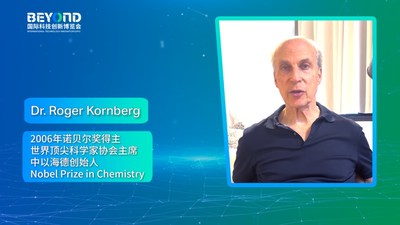BEIJING, Sept. 27, 2022 /PRNewswire/ — Society has long faced public health challenges in developing better drugs at a lower cost, preparing for future pandemics, and preventing diseases. During the opening day of BEYOND Expo 2022, Dr. Roger Kornberg, the 2006 Nobel Prize winner in Chemistry, shared several new tech approaches, such as quantum mechanical calculations and RNA therapies, aimed at solving long-standing health sector challenges.
On Wednesday, the BEYOND Expo 2022 opened online at BEYOND Metaverse. The week-long Expo will have more than 40 talks and panel discussions where leaders and experts across sectors dive deep into the topics of consumer tech, health tech, global investments, sustainability, and Web3.
Please find below the transcript of the opening day speech from Dr. Roger Kornberg, laureate of the 2006 Nobel Prize in Chemistry. The following transcript has been edited for clarity:
Good day, I am Roger Kornberg, and I will speak to you about what’s next in human health.
I’ll speak to you about something old and something new. What is old are the longstanding challenges, three of which I’ll address today. What’s new are emergent technologies that offer potential solutions to these important problems.
The long-standing challenges include the development of better drugs at a lower cost more rapidly, and secondly, future pandemic preparedness. And finally, prevention, which is, of course, better than cure.
There’s a saying: an ounce of prevention is worth a pound of cure. There’s no question that if a disease can be prevented, that’s far better than allowing it to occur and then trying to treat it.
In regard to the first challenge, better drugs more rapidly at lower cost, I will explain that the best current approach for drug development entails the solution of the molecular structure of a drug candidate bound to its protein target.
Based on the structure, the drug candidate can be redesigned to improve the fit to the target.
The improved design is then subjected to chemical synthesis and testing. The process is repeated to enhance further structure determination, molecular design, synthesis, and testing.
It is repeated many times. The process is expensive and laborious. It costs a lot of money.
It takes a long time. And the process is limited by time and money, as a result of which, drugs are often produced that fail clinical trials.
The solution to the problem is advanced computation. It has long been hoped that computer-aided drug design would enhance the process. The problem is that until now, that was not possible, or at least not to the extent that was hoped for. The strength of interaction between a potential drug and its target was limited by the capacity for computation.
Ideally, one computes using the full power of chemistry, one computes using quantum mechanics. Unfortunately, a full computation by that approach takes at least a trillion years for a single molecular design. The available methods are much more rapid. They can be accomplished in minutes, but they don’t achieve the accuracy required.
What is new is a method of quantum mechanical calculation that is sufficiently rapid and achieves the desired accuracy.
With this new approach, only beginning to be applied, it will be possible to make molecules that are much more potent, much faster, in much less time. And ultimately, without any requirement for synthesis or testing at all.
The second longstanding challenge that I wish to address is future pandemic preparedness. Obviously, of great importance in light of all our recent experience.
The solution to this problem will come from RNA therapy. I speak not of messenger RNA to produce vaccines, but rather, RNA molecules that are 100 to 1,000 times smaller, only about 20 to 25 RNA building blocks or nucleotides in length.
These are called small interfering RNAs. If introduced in cells, they lead to recognition of a gene sequence in a messenger RNA, corresponding to that in the small interfering RNA and a perfect match leads to the destruction of the messenger RNA.
In this way, by introducing a small interfering RNA into cells, one can stop the progress of a viral infection, or interfere with a pathway leading to unrestrained cell growth or cancer, and so forth.
The problem with this approach has been that small interfering RNAs approximately 20 to 25 nucleotides in length are nevertheless too large, and also too high and electrically charged to enter cells. They are unable to cross the surface, the bounding membrane that surrounds every cell.
The problem was solved by the recent discovery of a very small modification, a small molecule that could be attached to a small interfering RNA, that would enable its rapid penetration and accumulation in cells where the destruction of the protein of a virus or of another offending molecule is desired.
This approach has been applied to the development of SARS-CoV-2, a Covid drug with great success. It has resulted in 99.9% elimination of the virus from an infected animal.
The importance of this approach is not only how well it works, in the case of others that I might mention, but that the emergence of any new virus or a variant of an existing virus can be dealt with immediately. The genome sequence of the virus can be determined overnight. And the corresponding sequence of a small interfering RNA is created automatically actually on a machine. So the whole process from the appearance of a new virus to the availability of a drug is accomplished within a matter of days.
It’s further important to mention that small interfering RNAs persist in cells for a long time. So small interfering RNA drugs are not only therapeutic but also preventative. They are prophylactic. They will immunize an individual against infection for a period of weeks, if not longer. This is clearly a solution, not only to the problem of future pandemic preparedness but to viral disease and very many other conditions, in general. This is a wonderful, new approach that’s only just begun to be applied.
Finally, we come to prevention. Of course, that may take many forms.
I’ll cite one example of particular significance that has recently been developed. It pertains to air pollution, which, as you know, is a pressing problem everywhere in the world, and which is responsible for millions of deaths every year, for hundreds of millions of days lost from work or other activity due to disease, an economic cost to the world economy estimated at several trillion dollars a year.
The solution to this problem was developed for detection to warn an individual of exposure to air pollution. So a new, I should say extraordinary software was created that can be installed on any cell phone, the simplest of cell phones, which utilizes only the audio and visual capacities of any phone to measure very accurately every environmental parameter that includes the concentration of particulate matter in the air, especially so-called PM2.5, 2.5 micron particles, which pose the greatest hazard from air pollution.
But equally, the software I have mentioned can measure temperature to within 1 degree centigrade in the immediate vicinity of an individual with his or her phone.
It can measure the humidity. It can measure the wind direction. It can measure everything you might like to know. It will estimate ultraviolet light exposure and exposure to sounds that may be harmful.
This device will represent a warning system against every possible environmental hazard.
When carried by an individual, it will protect against conditions that would otherwise lead to disease or disability or what have you.
It may also be useful to conserve energy, a pressing problem around the world as well. So it won’t be necessary for the air-conditioner to be on in a house, or even part of a house or of a building, but only in the immediate vicinity of the individual whose exposure to heat or cold is of concern.
Finally and not less important, when installed on hundreds of millions, if not billions of cell phones, this technology will create an extraordinary data warehouse, an enormous data bank of information of very great value for human health, for insurance, against disease and other consequences of environmental conditions, for municipalities to design smarter cities and so forth.
To summarize then, I have described three long-standing challenges. They are the development of better drugs, future pandemic preparedness, and finally, the prevention of disease in the first place without having to resort to better drugs.
The solutions are at hand. The three examples I gave are fully developed and ready to apply. In the years to come, much better drugs will be made more rapidly at a much lower cost.
There should never be another pandemic. And finally, we should be well protected through a personal warning system from dangers inherent in the environment.
SOURCE BEYOND Expo



















